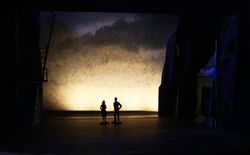
Barnum
Design Statement:
Barnum's central conflict takes shape as the characters of the show discuss opposing opinions about truth. One one hand, P.T. Barnum's business is based on lies and deception, which makes him morally corrupt. On the other hand, Barnum asks us to believe in the impossible, fill our lives with color, and accept with delight and humor the things the unexpected. My design allows space for both of these opinions. Luxurious textures and period Victorian elements are paired with the raw, traveled, and revealing nature of the circus.
Color Model
 |  |  |
|---|---|---|
 |  |
Research/Storyboards
 |  |  |
|---|---|---|
 |  |  |
 |  |  |
 |  |  |
 |  |  |
 |  |
Process Photos
 |  |  |
|---|---|---|
 |
Drafting




West Side Story
Design Statement:
My Design for West Side Story began with architectural research of New York City. From there, I looked into Puerto Rican design, grafitti, and culture, and arrived at a dripping multi-color paint treatment. The abstract black structures on top of these set pieces add to this contrast while creating dimension, negative space, and conflict in the environment. There are two structures stage left and stage right that track on and offstage, as well as scenery pieces upstage which can track side to side to create different street scenes and open space.
Color Model
 |  |  |
|---|---|---|
 |  |  |
 |  |  |
 |  |  |
 |  |
Research Images
 |  |  |
|---|---|---|
 |  |  |
 |  |  |
 |
White Model Photos




La Fille du Pharaon
Design Statement:
Though currently a part of the Bolshoi Ballet Company's reperatore, La Fille du Pharaon (composed by Cesare Pugni in 1862) is somewhat of a lesser-known ballet. This design was inspired through the textures and weight of Ancient Egypt, as well as incorporating vivid and etherial colors of fantasy locations. I chose to do a complete set of stage renderings in watercolor, guache, and sepia ink, as I felt they perfectly captured the dream journey of this story.
Watercolor Stage Renderings
 |  |  |
|---|---|---|
 |  |  |
Research Images
 |  |  |
|---|---|---|
 |  |  |
 |
Pencil Sketches
 |
|---|
 |
 |
 |
 |
White/Paper Model Photos




Blues for an Alabama Sky
Color Model
Design Statement:
 |  |
|---|---|
 |  |
 |
Blues for an Alabama Sky by Pearle Cleage takes place in 1930's Harlem during the ending waves of the Harlem renaissance in a complex environment fueled by segregation, hate, and the empowerment of the African American community. I found my greatest inspiration in paintings by Aaron Douglas. I overlayed Douglas's images onto my scenery to illustrate the history of what was, and look towards and what could be. The exterior is a harsh and unforgiving New York City. The interior is warm and inviting, though run down.
Research Images
 |  |
|---|---|
 |  |
 |  |
 |



White Model
Dangerous Liaisons
Color Model Photos
 |  |
|---|---|
 |  |
 |  |
 |  |
Storyboard Renderings
 |  |
|---|---|
 |  |
 |  |
 |  |
Design Statement:
My first design in the Rococo era, Dangerous Liaisons proved to be challenging in terms of stage economy. Because the location changes after almost every scene, I needed to find a way to smoothly and quickly transition au-vista. I took advantage of the flying space of the theatre to bring in Rococo inspired "frames" for each location. Tourvel, Rosemonde, and Merteuil's Salons have furniture pre-set on wagons that track from each side to meet on the centerline, or track from the back as a whole piece. This allowed me to achieve the grandeur of furnished salons without wasting production time to set and strike furniture. Because each space is owned/inhabited by specific characters, color proved to be immensely important to clue the audience to the location's owner and thus the context of each space.
White Model Process
 |
|---|
 |
 |
 |
The Tempest
Color Model Photos
 |  |
|---|---|
 |  |
Design Statement:
My design for Shakespeare's The Tempest focused on the magical qualities of the character Prospero, and how he might effect the island. I researched seemingly magical happenings that occur naturally, as in rock arches, twisted tree growth, and fossilized opals. The rock structure in my set is meant to glow and change color within its cracks (assisted by lighting), and the metal apparatuses are meant for aerial dancers to convey the sprites and magical beings of the island.
Research Images










